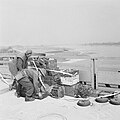
The Teller mine (German : Tellermine) was a German-made antitank mine common in World War II. With explosives sealed inside a sheet metal casing and fitted with a pressure-actuated fuze, Teller mines had a built-in carrying handle on the side. As the name suggests (Teller is the German word for dish or plate) the mines were plate-shaped.


